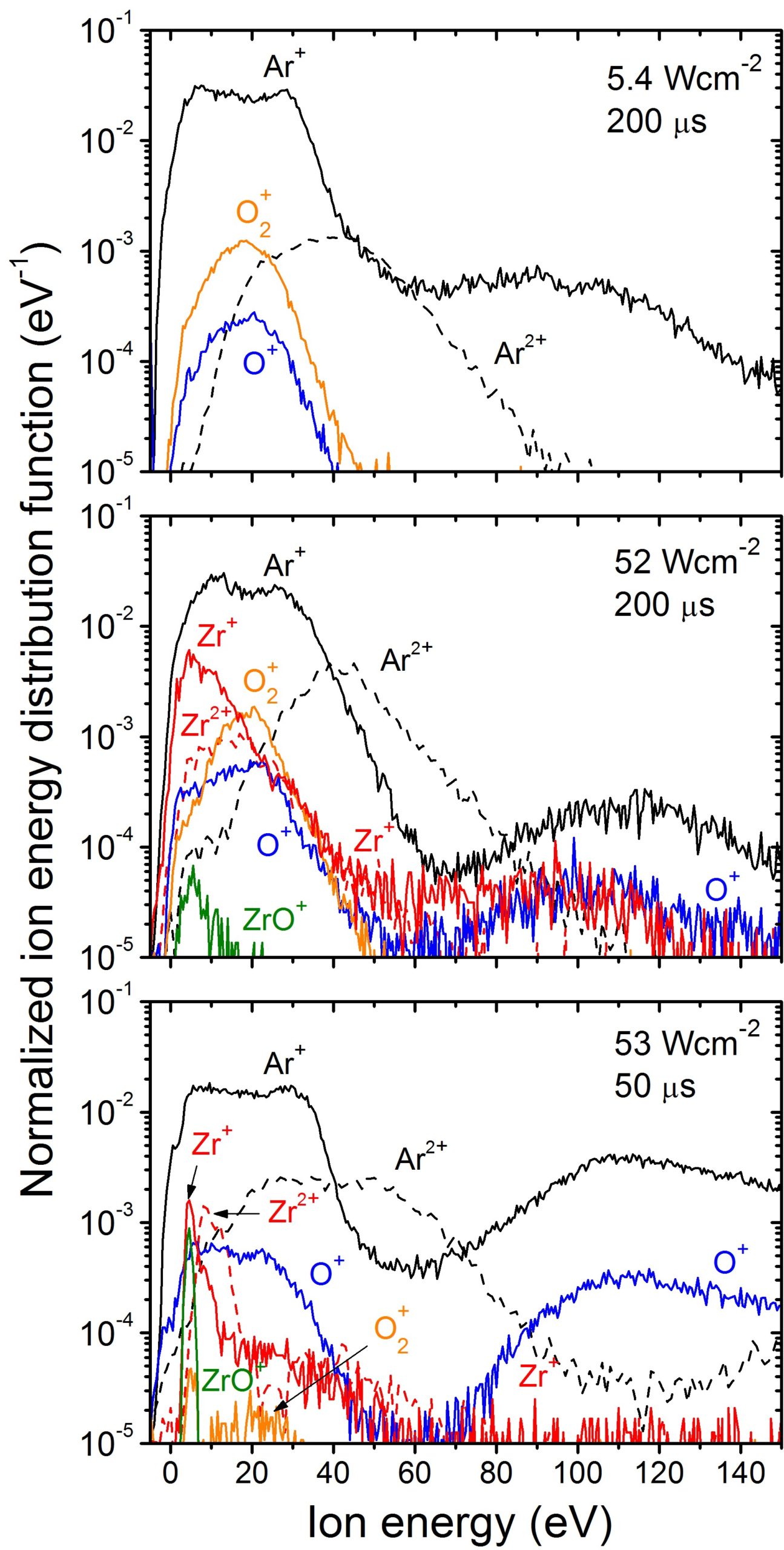In spite of several successful applications of high-power impulse magnetron sputtering (HiPIMS) systems to reactive sputter depositions of dielectric oxide films, there are still substantial problems with arcing on target surfaces during the reactive deposition processes at high target power densities, particularly for voltage pulses longer than 40 μs, and with low deposition rates achieved.
 To avoid these problems, we have proposed a pulsed reactive gas flow control (RGFC) of the reactive HiPIMS processes. In this work, HiPIMS with the pulsed RGFC was used for high-rate reactive depositions of densified, highly optically transparent ZrO2 films onto floating substrates at the distance of 100 mm from the target. An optimized location of the oxygen gas inlets in front of the target and their orientation toward the substrate made it possible to improve quality of the films due to minimized arcing at the sputtered target and to enhance their deposition rates up to 120 nm/min at the deposition-averaged target power density of 52 Wcm-2, the voltage pulse duration of 200 µs and the substrate temperature less than 120 °C. The films exhibited a hardness of 16 GPa, a refractive index of 2.19 and an extinction coefficient of 2×10-3 (both at the wavelength of 550 nm). The time-averaged energy distributions of positive and negative ions were measured with a Hiden Analytical EQP 300 energy-resolved mass spectrometer placed at the substrate position. Figure 1 shows very high (Zr+ + Zr2+) ion fractions in the total fluxes of positive ions onto the substrate at the deposition-averaged target power densities close to 50 Wcm-2 when the highest deposition rates of the ZrO2 films were achieved. For the shorter voltage pulses (50 μs), we observed a predominance of the O+ ions over the O2+ ions in the flux onto the substrate due to a very strong dissociation of O2 molecules in a discharge plasma at high values of the pulse-averaged target power density being close to 2 kWcm-2. For the to-substrate O2 inlet, the high-energy parts of the time-averaged energy distributions of Ar+ and O+ ions are more pronounced, particularly at the short high-energy pulses. This is mainly caused by a backscattering (reflection) of light O and Ar atoms from the sputtered Zr target with a small coverage by a Zr oxide.
To avoid these problems, we have proposed a pulsed reactive gas flow control (RGFC) of the reactive HiPIMS processes. In this work, HiPIMS with the pulsed RGFC was used for high-rate reactive depositions of densified, highly optically transparent ZrO2 films onto floating substrates at the distance of 100 mm from the target. An optimized location of the oxygen gas inlets in front of the target and their orientation toward the substrate made it possible to improve quality of the films due to minimized arcing at the sputtered target and to enhance their deposition rates up to 120 nm/min at the deposition-averaged target power density of 52 Wcm-2, the voltage pulse duration of 200 µs and the substrate temperature less than 120 °C. The films exhibited a hardness of 16 GPa, a refractive index of 2.19 and an extinction coefficient of 2×10-3 (both at the wavelength of 550 nm). The time-averaged energy distributions of positive and negative ions were measured with a Hiden Analytical EQP 300 energy-resolved mass spectrometer placed at the substrate position. Figure 1 shows very high (Zr+ + Zr2+) ion fractions in the total fluxes of positive ions onto the substrate at the deposition-averaged target power densities close to 50 Wcm-2 when the highest deposition rates of the ZrO2 films were achieved. For the shorter voltage pulses (50 μs), we observed a predominance of the O+ ions over the O2+ ions in the flux onto the substrate due to a very strong dissociation of O2 molecules in a discharge plasma at high values of the pulse-averaged target power density being close to 2 kWcm-2. For the to-substrate O2 inlet, the high-energy parts of the time-averaged energy distributions of Ar+ and O+ ions are more pronounced, particularly at the short high-energy pulses. This is mainly caused by a backscattering (reflection) of light O and Ar atoms from the sputtered Zr target with a small coverage by a Zr oxide.
Figure 1. Normalized time-averaged energy distribution functions of dominant positive ions at the substrate position measured for the to-substrate O2 inlet at the deposition-averaged target power density of 5.4 Wcm-2 to 53 Wcm-2 and the voltage pulse duration of 50 µs and 200 µs.
 Project summary by: Dr Jiri Rezek, Department of Physics and NTIS, European Centre of Excellence Univerzitní 8, 30614 Plzeň, Czech Republic
Project summary by: Dr Jiri Rezek, Department of Physics and NTIS, European Centre of Excellence Univerzitní 8, 30614 Plzeň, Czech Republic
Paper Reference: Vlček, J. Rezek, J. Houška, T. Kozák, J. Kohout (2015) “Benefits of the controlled reactive high-power impulse magnetron sputtering of stoichiometric ZrO2 films” Vacuum 114, 131-141
Hiden Product: EQP
Project Summary Reference: AP1008
To find out more about these products visit the EQP product page or if you would like to contact us directly please Send us a Message.

